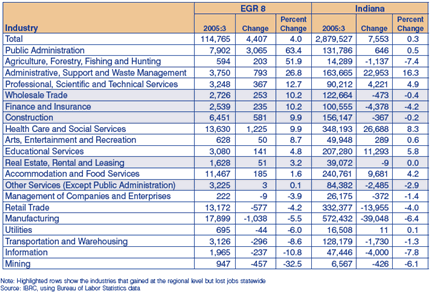Regional Perspective: Economic Growth Region 8
Economic Growth Region (EGR) 8 is located in the central southwestern portion of Indiana and consists of the following eight counties: Brown, Daviess, Greene, Lawrence, Martin, Monroe, Orange and Owen. With a combined 2005 population nearing 300,000 people, the region made up 4.8 percent of the state's population. While population changes have been somewhat inconsistent at the county level (see Figure 1), the region has seen an overall population gain of about 3,680 people from July 2000 to 2005; across all five years, each county increased in population. Owen County showed the largest decrease from 2004 to 2005 but has actually added the most number of people over the five-year span, for an overall increase of 922 people. As seen in Figure 1, Martin County showed the least change since 2000, with an increase of only about 29 people.
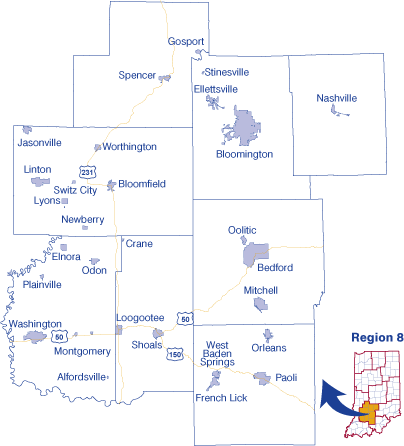
Figure 1: Change in Population in EGR 8, 2000 to 2005
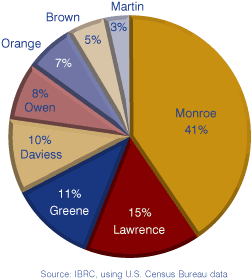
At the county level, Monroe County made up 41 percent of the region's population (see Figure 2). Located within Monroe County, the city of Bloomington (home to Indiana University's largest campus) makes up 23 percent of the region's population. That is more than any other county's population share (at second place, Lawrence County's share of the regional population is 15 percent).
Figure 2: Population Distribution, EGR 8

Jobs
There were about 7,000 establishments supplying jobs for 114,765 people in EGR 8 in the third quarter of 2005, making up 4 percent of all jobs in the state. This is up from 3.8 percent of the state total in the same quarter of 2001.
Overall gains totaled more than 4,400 jobs for a 4 percent increase over the four years. That is 3.7 percentage points higher than the growth at the state level, which saw an increase of 7,553 jobs. The increase in jobs at the regional level can be mostly attributed to two industries: the public administration industry added 3,065 jobs and the health care and social services industry improved by another 1,225 jobs.
While manufacturing makes up a higher percentage of jobs at both the regional and state levels than any other single industry, it is not as prominent in EGR 8 as it is at the state level, with 15.6 and 19.9 percent of jobs, respectively. There were five industries that lost jobs at the state level but gained at the regional level:
- Construction
- Wholesale Trade
- Finance and Insurance
- Real Estate, Rental and Leasing
- Other services
Meanwhile, the utilities industry was the only one to lose jobs in EGR 8 and add statewide (see Table 1).
Table 1: Jobs in Indiana and EGR 8, 2001:3 to 2005:3
Wages
Along with adding jobs, Region 8 saw an increase of $82 in average weekly wages. Despite this increase, EGR 8 still pays less than the state average by $93 per week. An even closer look reveals that only two individual industries paid higher wages in the region than in the state: management of companies and enterprises paid more at the regional level than it did statewide by an average of $896 per week and public administration paid an average of $209 more per week in EGR 8 than in Indiana overall. Figure 3 compares Region 8s average weekly wages to those of the state.
Figure 3: Average Weekly Wages in Indiana and EGR 8, 2005:3
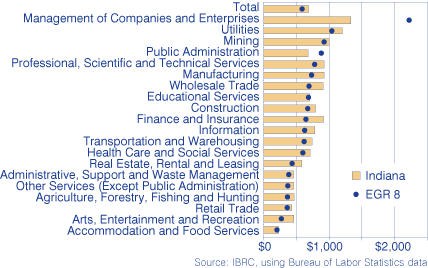
Three industries in Region 8 saw a decrease in average weekly wages: agriculture, forestry, fishing and hunting (down by $2 per week); arts, entertainment and recreation (down by $16 per week); and management of companies and enterprises (down by $583 per week). Despite the large drop in average weekly wages for the management of companies and enterprises industry, it still pays almost $900 more per week at the regional level. Meanwhile, Indiana increased wages in every major industry sector.
Commuting
Of the approximate 140,500 people who make up the regional labor force (defined as those who live in the region and work anywhere), 70.5 percent choose to work in the same county in which they live and 85.6 percent stay within EGR 8 boundaries. That leaves about 20,300 people working outside the region. Meanwhile, 7,468 people live outside the region and commute in for work. Figure 4 shows the county-level commuting patterns.
Let's take a closer look at the 85.6 percent of the labor force that works within the region. Brown County receives and sends the fewest number of workers to the other seven EGR 8 counties, with 359 coming in and 755 leaving (see Table 2). At the other end of the spectrum, Monroe County receives the most workers (11,798) and Lawrence County sends out the most (5,830 workers).
Figure 4: EGR 8 Commuting Patterns, 2000
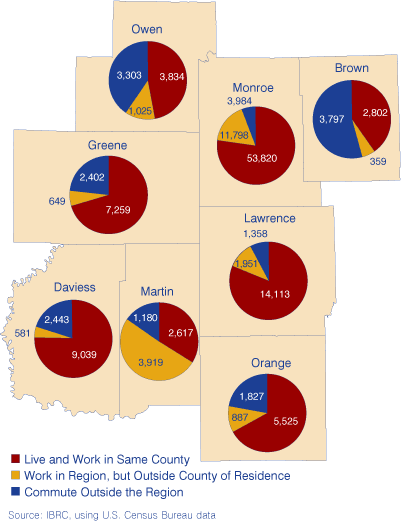
Table 2: Intra-Regional Commuting, 2000
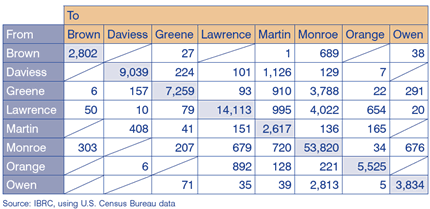
Sidebar: Economic Developments in EGR 8
The U.S. Economic Development Administration (EDA) is funding research to develop a “clusters of innovation” model that can be used in America's rural communities. The strategy developed by analyzing Region 8s demographic, economic and industrial composition is intended to set the stage for the implementation of an ongoing regional initiative to stimulate new investment and job creation within all participating counties.
This map shows the locations for businesses in the region that had at least $1 million in sales in 2004. The city of Bloomington in Monroe County shows the heaviest concentration of these businesses. Martin County claims the least number of businesses in this category, but does have the Crane Naval Surface Warfare Center.
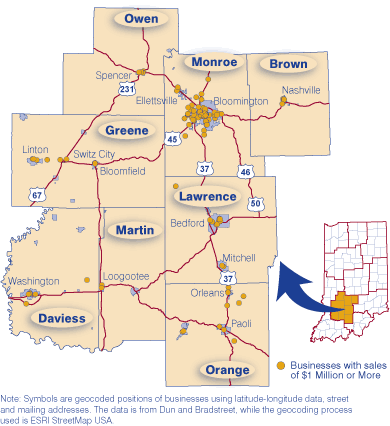
For more maps, data and the preliminary report about the region, state and nation, visit www.ibrc.indiana.edu/innovation.
Molly Marlatt, Research Associate
Indiana
Business Research Center, Kelley School of Business, Indiana University

